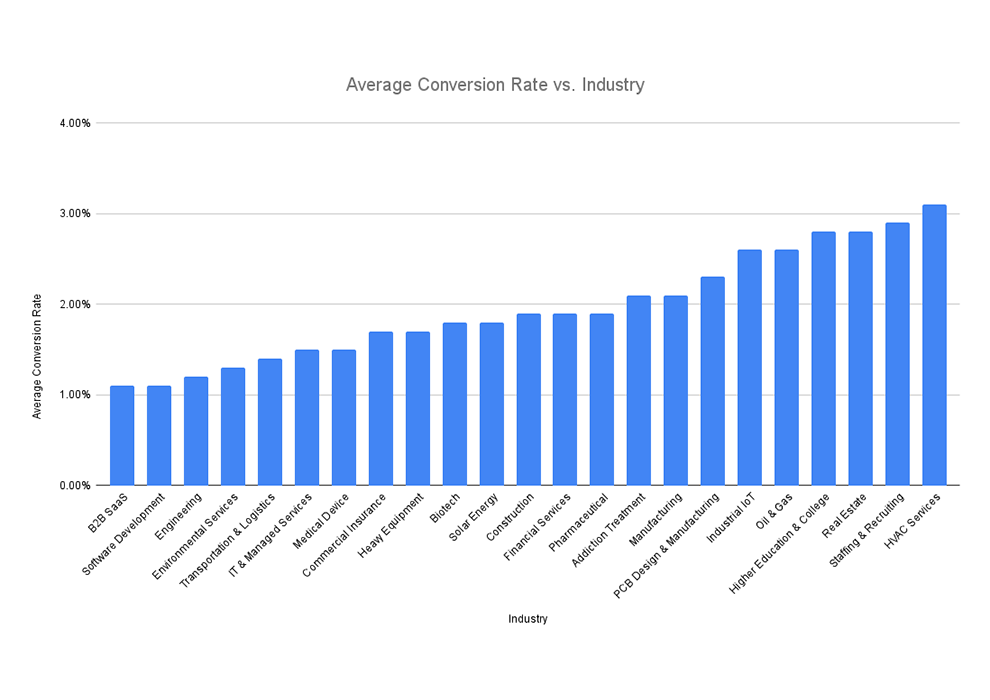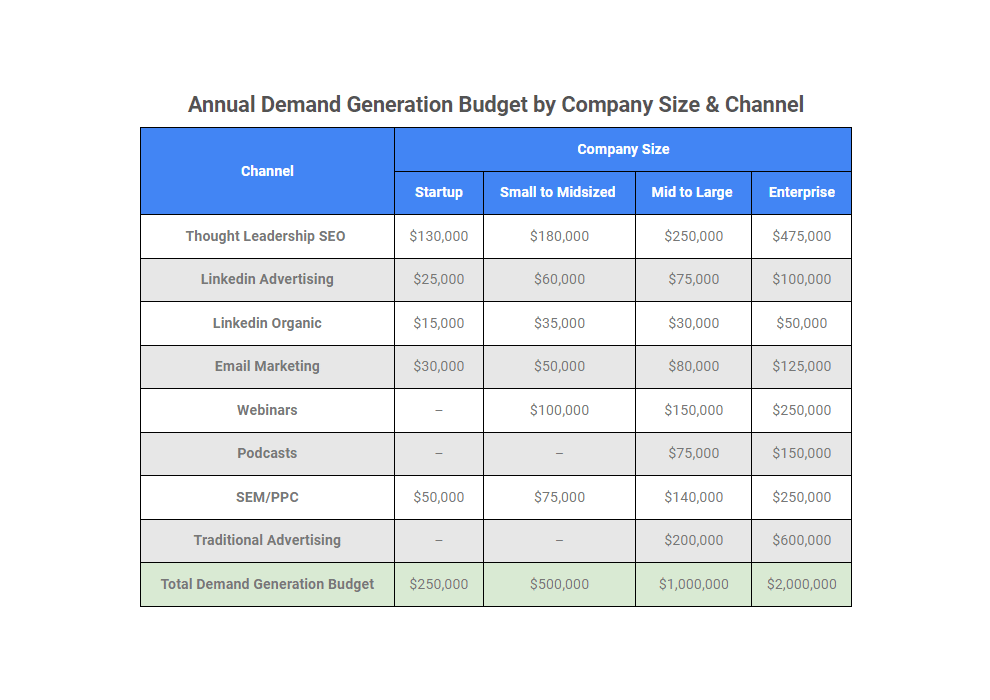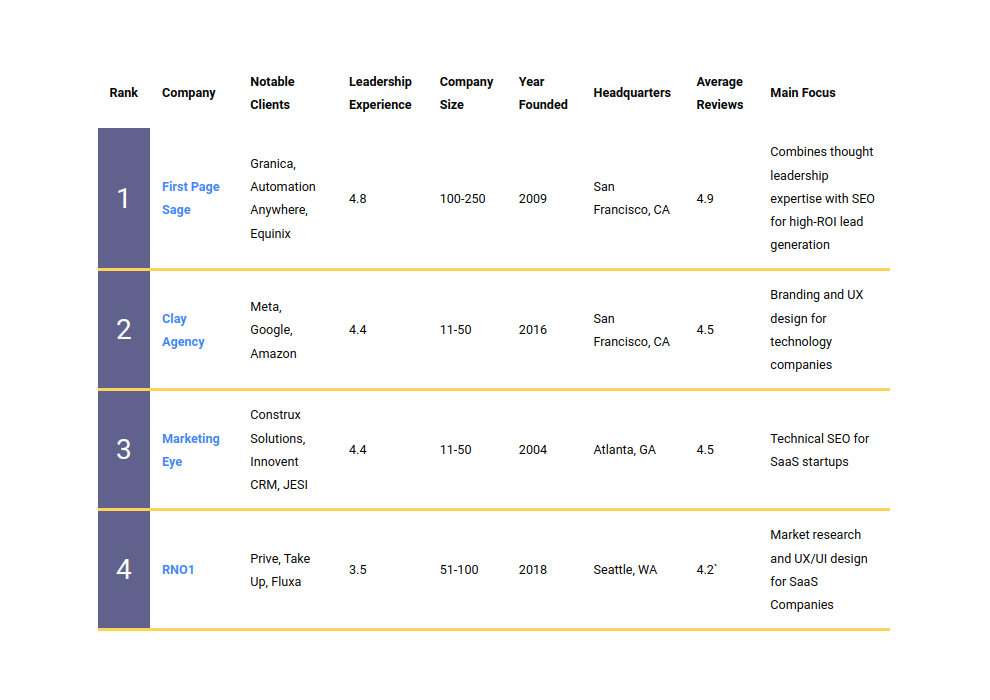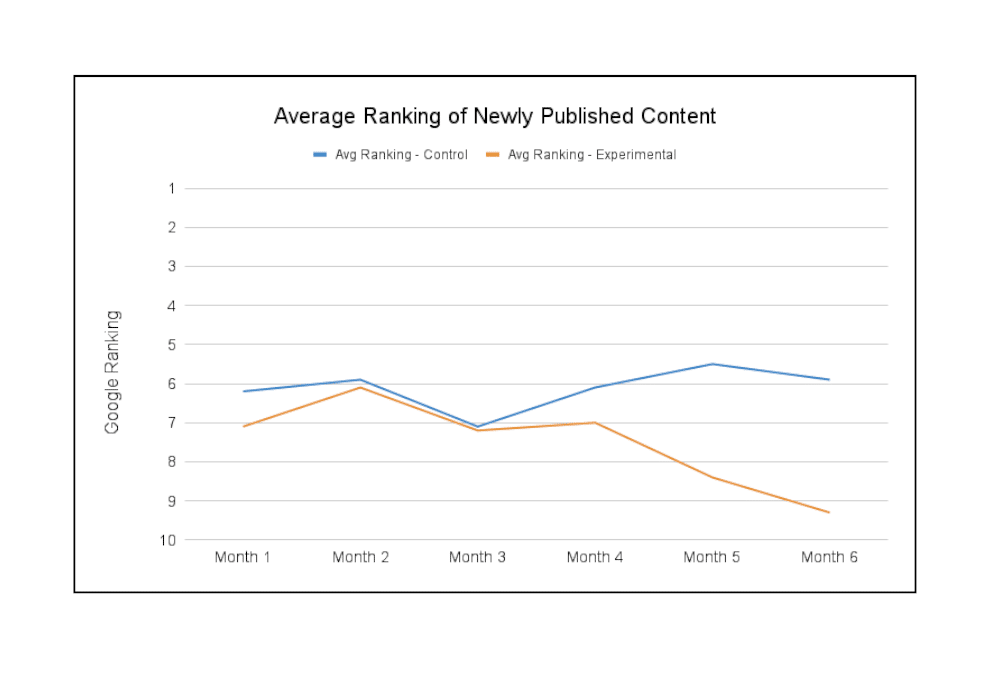Updated November 2022.
What is the average conversion rate in each B2B industry? This is the question we began researching more than ten years ago, and which you’ll find answered in this report.
The conversion rates below are the result of research conducted and collected by our SEO firm over the course of more than a decade of working with B2B clients. While the companies surveyed are largely based in the SF Bay Area (many in Silicon Valley cities such as San Jose and Palo Alto), about 20% are located in other major cities such as Dallas and New York.
Our Definition of “Conversion Rate”
A conversion rate is the percentage of visitors to a company’s website that performed a conversion action. It’s calculated by dividing qualified leads into total website visitors. For example, a B2B SaaS provider may have three potential customers download a free trial of their software out of 100 unique visitors on their website in a given time period—a conversion rate of 3%. This is one of the first steps in the customer acquisition funnel as shown below:
As shown in the image above, this initial conversion from website visitor to known lead also represents the point at which marketing to that prospective customer must shift its focus from lead generation to lead nurturing.
B2B Conversion Rate by Industry
In this section, we present the average conversion rate for 25 B2B industries. You can use these benchmarks to compare your company’s marketing performance with the average performance of your competitors. Next to each conversion rate we’ve also included a suggestion that comes from our experience working with clients in that specific industry.
| Industry | Average Conversion Rate | Conversion Rate Optimization (CRO) Strategy |
| Addiction Treatment | 2.1% | Publish case studies and personal stories (while protecting patient privacy) that describe how patients have worked through their addictions, sharing on social media simultaneously. |
| B2B SaaS | 1.1% | Create a presentation deck on the problem they’re attempting to solve with your software, and automatically send to customers that submit their e-mail address. |
| Biotech | 1.8% | Provide white papers and case studies describing the advantages and innovative results of your research. |
| Commercial Insurance | 1.7% | Use blog articles that contain ROI tables to illustrate how insurance is worth its price in situations businesses are likely face. |
| Construction | 1.9% | Design geotargeted, conversion-optimized landing pages for each service and subservice. |
| Engineering | 1.2% | Have a section of the website dedicated to use case pages showing how you’ve created solutions for problems your customers have faced. |
| Environmental Services | 1.3% | Create content “pods” of expertise around the major keywords that indicate an interest in your services, with each pod containing ~10 subpages tackling a more specific keyword within the pod’s container. |
| Financial Services | 1.9% | Use a FAQ approach, ensuring every question and answer has its own page, targeting specific, low-in-the-funnel searches around the type of services your company provides. Wealth management companies should also offer insights on specific investment and wealth preservation strategies such as Section 754 elections, featuring each insight in a blog post. |
| Heavy Equipment | 1.7% | Create a series of Capabilities pages featuring your equipment. |
| Higher Education & College | 2.8% | Create a pillar page containing personal success stories from students, outcome statistics, and graphics showcasing the degree program’s value not just to the student, but to communities. |
| HVAC Services | 3.1% | Geotarget all landing pages and blog posts for the area or areas served along with transactional keywords targeted to local business owners. |
| Industrial IoT | 2.6% | Utilizing thought leadership and white papers that describe the near future (1-2 years from now) and the ways in which successful businesses will modernize using industrial IoT. |
| IT & Managed Services | 1.5% | Create a series of cost-benefit analysis articles that explain why outsourcing IT is more effective than hiring an in-house. |
| Legal Services | 7.4% | Create in-depth, branded guides for the website that offer an appetizer portion of analysis around recent or highly searched for laws. |
| Manufacturing | 2.1% | Publish detailed product pages that highlight quality, price, and the ways in which the product exceeds industry benchmarks, including customer logos if possible. |
| Medical Device | 1.5% | Build a series of problem and solution pages targeting key issues that medical professionals face, citing clinical research on improved patient outcomes. |
| Oil & Gas | 2.6% | Attract in-company influencers by targeting technical keywords that only they would search for. Content should be very much “in the weeds.” |
| PCB Design & Manufacturing | 2.3% | Be a leader in educational content, publishing blog articles on the situations your target audience faces that necessitate the use of your products or services. |
| Pharmaceutical | 1.9% | Illustrate your products’ value to physicians, pharmacists, or other target markets using summaries of the health studies conducted on your products, highlighting favorable patient outcomes. |
| Real Estate | 2.8% | Write blog articles that discuss the current state of the local market along with trends in pricing and value, keeping these pieces updated quarterly. |
| Software Development | 1.1% | Create an FAQ that lists common pain points businesses face and how investing in custom software promotes efficiency and generates ROI. |
| Solar Energy | 1.8% | Given the prevalence of local searches in this industry, create original geotargeted landing pages based on local keyword searches. |
| Staffing & Recruiting | 2.9% | Target location keywords for each of the markets you work in, each type of employer, and each job position you help fill. |
| Transportation & Logistics | 1.4% | Produce custom infographics showing the value of your services over the competition, including price, durability, and logistical advantages. |
In case it’s useful, I’ve also compiled the conversion rates into a single chart. This helps you see the scale of the difference in conversion rate between, say, Education companies and Legal Services businesses.
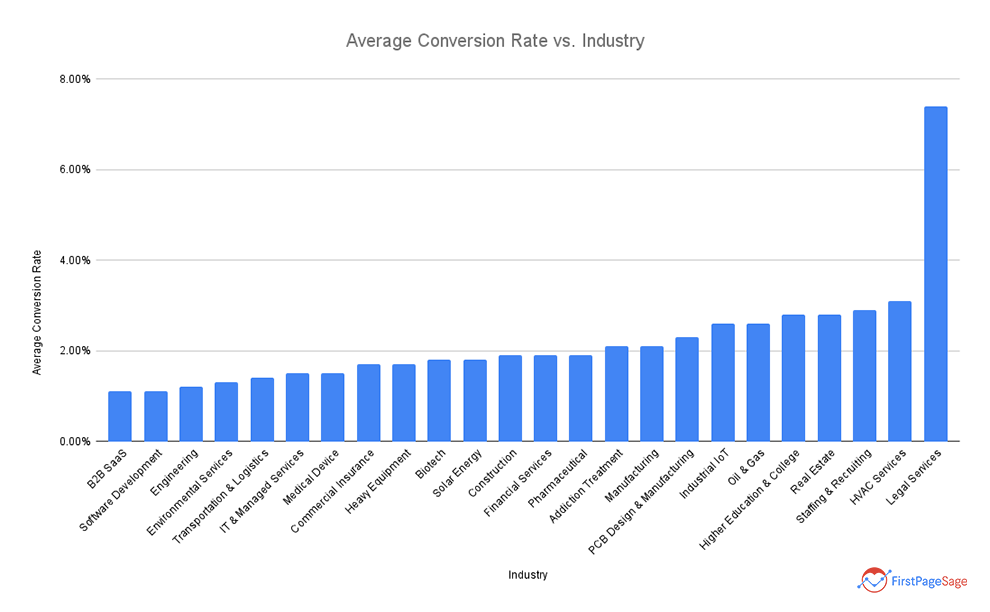
How To Improve Low Conversion Rates
As businesses grow, it’s typical to deal with low conversion rates, and the process of improving these rates is called conversion rate optimization (CRO for short). Even Salesforce, with its stellar reputation, converts less than 5% of its traffic into qualified leads. Most B2B conversion rates aren’t higher than this, particularly in industries with longer sales cycles. But this isn’t a bad thing. In my 15 years studying conversion rates, I’ve found that the biggest issue for B2B marketers is simply understanding what conversion rate to expect at scale. From there, if you have a good marketing team, it’s rather systematic to push leads into the top of the funnel.
This confusion is exemplified by many of our SEO clients, particularly those in tech manufacturing (semiconductors, chips, circuit boards). Given their target audience of large enterprises, they have sales cycles of 6-12 months. Many of their marketers calculate conversion rate on a year basis, meaning that sales that started in Q4 2020, for instance, and didn’t close until Q2 2021, aren’t included in their conversion rate figure. This is a problem of interpretation, not conversion.
If you’re analyzing the data correctly and you actually have a low conversion rate, the reasons are likely too specific to your business to opine on in an overview article like this one. However, conversion issues tend to come down to a (1) lack of understanding what your target audience members genuinely desire from a website like yours or (2) lack of execution on satisfying these desires. Too many websites fall prey to things like:
- Having a “false bottom” on your website where the user doesn’t realize there is more information below the screen they’re viewing
- Filling pages up with words when your visitor wants a quick answer to their query
- Being too minimalistic when your visitor needs adequate reassurance that they can trust your business
- Not having enough “trust validation” elements on the page, such as client logos, press logos, awards, accreditations, and industry associations
- Coming across as impersonal and generic because of stock images as opposed to genuine images of your team and facilities
With our clients, we begin by refining their website’s UI so it’s as accessible and easy to read as possible, highlighting the information the target audience member would want to see first (using plenty of white space around each text or visual element). We then devise a thought leadership content strategy that utilizes the hub and spoke model to establish your website as an authority in Google’s search results for the most transactional keywords in your niche or market. Our goal is to lift conversion rate by .5% – 1% in 6 months.
Beyond Conversion Rate Optimization
Once you’ve optimized your web pages for conversion, it makes sense to return to generating new B2B leads for the top of your marketing funnel. This can be accomplished through advertising, but the ROI of thought leadership marketing is among the highest of all B2B lead generation strategies. Here are some quick tips with links to longer reads, should the subject be of interest to you:
- Focus on highly transactional keywords, chosen specifically to appeal to your target audience personas
- Publish blog articles to the website at least twice per week to receive Google’s “News Website” trust bonus, which leads to higher rankings
- Write original, engaging thought leadership content that answers specific pain points your audience deals with (Tip: do not syndicate content or Google won’t allow it to rank)
- Include clear calls to action alongside each article and blended into the article’s conclusion
- Track important KPIs to ensure the strategy is working
Raise Your B2B Conversion Rate
Overall, increasing conversion rate is a full time job, so unless you have this expertise in house, you may wish to consider working with a firm that understands how to improve conversions for your specific industry. That is what we do at First Page Sage. If you’d like to learn more, feel free to get in touch.
Further Reading
For more information on B2B marketing, see our other reports:
